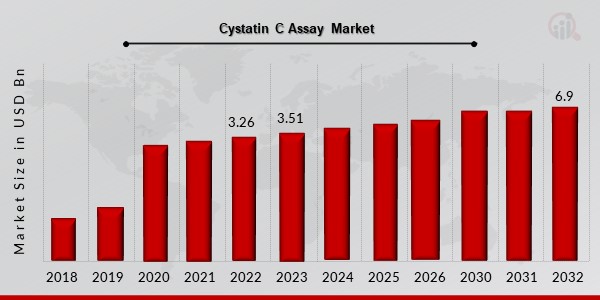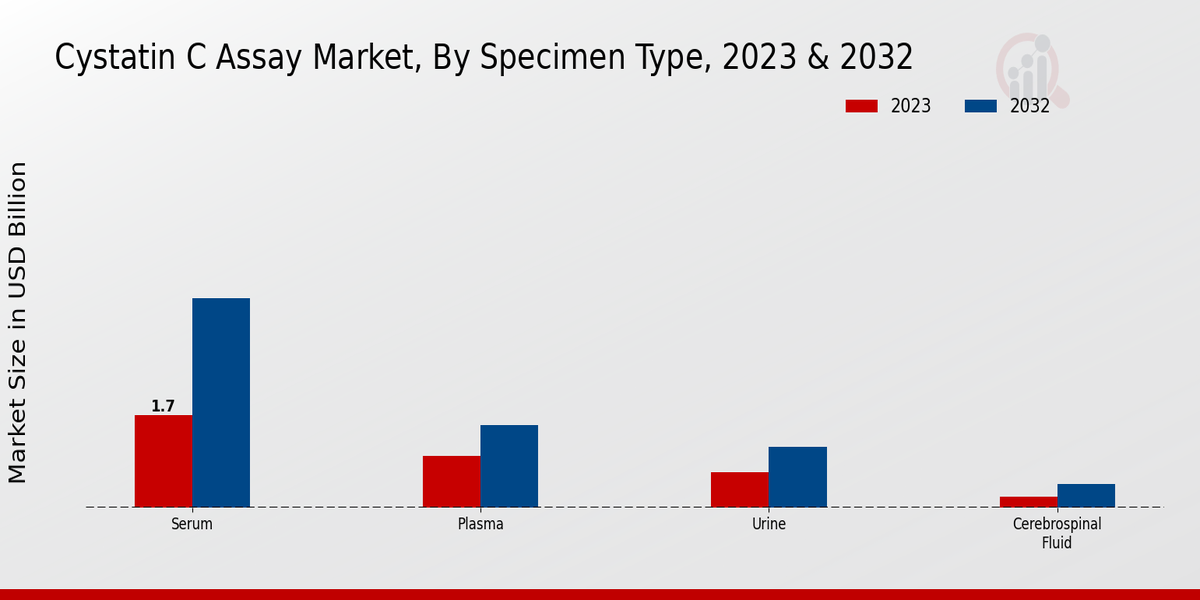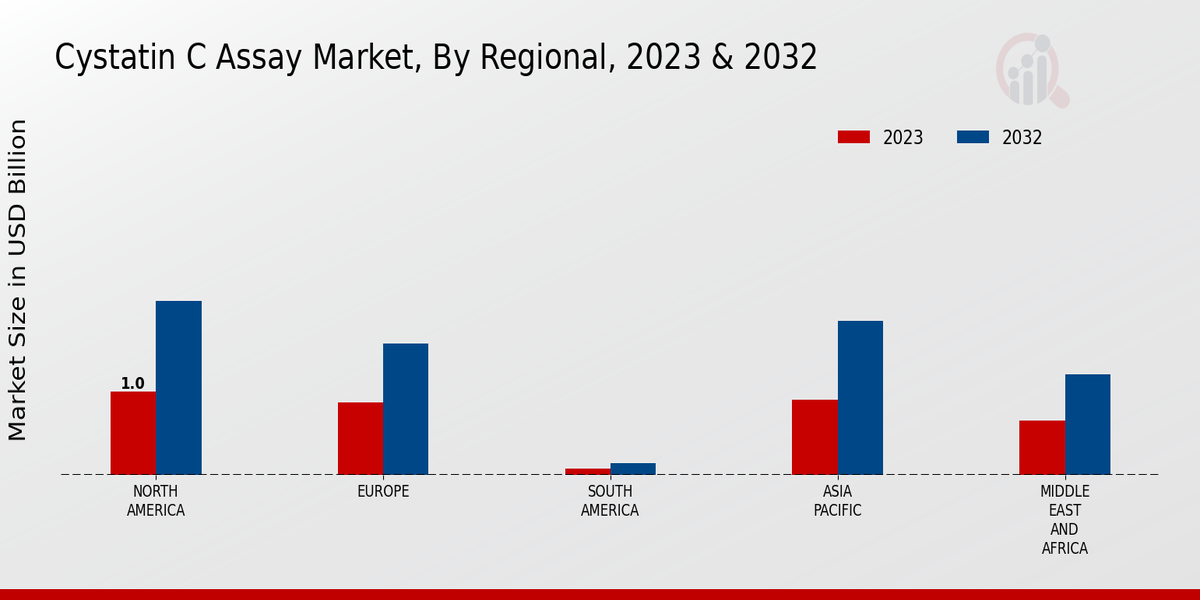Global Cystatin C Assay Market Overview:
As per MRFR analysis, the Cystatin C Assay Market Size was estimated at 3.26 (USD Billion) in 2022. The Cystatin C Assay Market Industry is expected to grow from 3.51(USD Billion) in 2023 to 6.9 (USD Billion) by 2032. The Cystatin C Assay Market CAGR (growth rate) is expected to be around 7.8% during the forecast period (2024 - 2032).
Key Cystatin C Assay Market Trends Highlighted
Key market drivers for the Cystatin C Assay market include the rising prevalence of chronic kidney diseases, increasing demand for early and accurate kidney function assessment, and growing awareness of cystatin C as a reliable biomarker for kidney function.
Opportunities for growth in the market lie in the development of novel assay technologies with improved sensitivity and specificity, expanding applications in non-invasive diagnostics, and collaborations between market players to provide comprehensive solutions for kidney function assessment.
Recent trends in the market include the adoption of automated assay systems for faster and more efficient testing, the integration of cystatin C assays with other diagnostic tests for a more comprehensive assessment, and the increasing use of point-of-care testing devices for convenient and accessible kidney function monitoring.

Source: Primary Research, Secondary Research, MRFR Database and Analyst Review
Cystatin C Assay Market Drivers
Rising Prevalence of Chronic Kidney Disease
Chronic kidney disease is considered to be one of the serious public health problems that affect millions of individuals worldwide. It is characterized as kidney function’s gradual decrease, eventually leading to kidney failure. Cystatin C is a biomarker used to assess kidney function, and elevated levels of cystatin C are correlated with an increased risk of development of chronic kidney disease. Thus, with the increasing prevalence of CKD as the key growth driver of the Cystatin C Assay Market Industry, the demand for these assays corresponds to rising needs.According to the National Kidney Foundation, more than 37 million adults in the United States have chronic kidney disease, which is expected to grow to more than 40 million by 2032.
Technological Advancements in Cystatin C Assay Techniques
The technological progress in terms of cystatin C assay is the other considerable driver behind the increase of the Cystatin C Assay Market Industry. To be more exact, the peculiarities of the previous version of this technology, namely, the fact that it was too time-consuming and laborious, hence not exactly suitable to the clinical setting. However, the current trend in the given realm can be described as the creation of an automated and high-throughput variety of the assay.This type is far faster than the previous one, more accurate and far more user-friendly. Thus, the automated and high throughput assay will be adopted by a greater number of healthcare providers in the future, driving the Cystatin C Assay Market Industry further.
Increasing Awareness of the Importance of Early CKD Detection
Growing awareness about the necessity of early identification for CKD may also be listed as one of the main growth drivers in the Cystatin C Assay Industry market. CKD is generally asymptomatic in the starting stages, and most people are not aware that they have CKD. But if CKD is detected and managed in the initial stages, it can help in retarding 80-90 percent of disease progress. As such, cystatin C assays are considered a major tool for the early identification of CKD.It is expected that the increasing demand for CKD awareness will increase the demand for cystatin C assay also.
Cystatin C Assay Market Segment Insights:
Cystatin C Assay Market Specimen Type Insights
The Cystatin C Assay Market is segmented by Specimen Type into Serum, Plasma, Urine, and Cerebrospinal Fluid. Among these, the Serum segment held the largest market share in 2023, accounting for over 55% of the Cystatin C Assay Market revenue. This dominance is attributed to the widespread availability of serum samples and the ease of collection compared to other specimen types. The Serum segment is projected to maintain its leading position throughout the forecast period, growing at a CAGR of 7.2% from 2024 to 2032. The Plasma segment is expected to witness significant growth during the forecast period, owing to the increasing adoption of plasma-based assays for Cystatin C measurement.Plasma samples offer several advantages over serum samples, including reduced interference from clotting factors and hemolysis. The Plasma segment is projected to grow at a CAGR of 8.1% from 2023 to 2032, reaching a market size of USD 1.25 billion by 2032. The Urine segment is anticipated to grow steadily over the forecast period, driven by the increasing use of urine samples for Cystatin C measurement in point-of-care settings. Urine samples are non-invasive and easy to collect, making them suitable for large-scale screening and monitoring of Cystatin C levels.The Urine segment is projected to grow at a CAGR of 6.9% from 2023 to 2032, reaching a market size of USD 0.92 billion by 2032. The Cerebrospinal Fluid segment is expected to witness a moderate growth rate during the forecast period, owing to the limited applications of Cystatin C measurement in cerebrospinal fluid. Cerebrospinal fluid samples are typically collected for diagnostic purposes and are not commonly used for routine Cystatin C measurement. The Cerebrospinal Fluid segment is projected to grow at a CAGR of 5.5% from 2023 to 2032, reaching a market size of USD 0.23 billion by 2032.Overall, the Cystatin C Assay Market is expected to experience steady growth over the forecast period, driven by the increasing demand for accurate and reliable Cystatin C measurement in various clinical settings. The growing awareness of Cystatin C as a biomarker for kidney function and the increasing adoption of point-of-care testing are expected to fuel market growth in the coming years.

Source: Primary Research, Secondary Research, MRFR Database and Analyst Review
Cystatin C Assay Market Assay Technology Insights
Immunoassay, nephelometry, and capillary electrophoresis are the three most common assay technologies used in the Cystatin C Assay Market. Immunoassay is the most widely used assay technology, accounting for over 60% of the Cystatin C Assay Market revenue in 2023. It is a highly sensitive and specific method that can be used to measure Cystatin C levels in a variety of samples, including serum, plasma, and urine. Nephelometry is another commonly used assay technology. It is less sensitive than immunoassay, but it is more cost-effective and can be used to measure Cystatin C levels in a wider range of samples.Capillary electrophoresis is a relatively new assay technology that is gaining popularity due to its high sensitivity and specificity. The growth of the market is being driven by the increasing prevalence of chronic kidney disease, which is a major risk factor for cardiovascular disease and stroke. Additionally, the growing awareness of the importance of early diagnosis and monitoring of kidney disease is also contributing to the growth of the market.
Cystatin C Assay Market Application Insights
Renal Function Assessment is anticipated to lead the Cystatin C Assay Market with a dominant revenue share by 2024. The rising prevalence of chronic kidney diseases, along with growing awareness about early disease diagnosis and management, are key drivers fueling segment growth. The cardiovascular Disease Risk Assessment segment is projected to witness substantial growth over the forecast period, owing to increasing recognition of cystatin C as a predictor of cardiovascular events. The Neurodegenerative Disease Diagnosis segment is expected to expand at a significant CAGR during the forecast period, driven by growing research linking cystatin C levels to the development and progression of neurodegenerative diseases like Alzheimer's and Parkinson's.The Autoimmune Disease Monitoring segment is anticipated to register steady growth over the forecast period, supported by the use of cystatin C as a biomarker for monitoring disease activity and response to treatment in autoimmune conditions like rheumatoid arthritis and lupus.
Cystatin C Assay Market End-User Insights
The end-user segment of the Cystatin C Assay Market is segmented into hospitals and clinics, research laboratories, and diagnostic centers. Hospitals and clinics are the primary end-users of cystatin C assays, accounting for over 50% of the market revenue in 2023. The increasing prevalence of chronic kidney disease (CKD) and the growing demand for accurate and timely diagnosis are driving the growth of this segment. Research laboratories are also significant end-users, as they utilize cystatin C assays for biomarker discovery and validation.Diagnostic centers are expected to witness significant growth in the coming years due to the increasing outsourcing of laboratory testing services. The Cystatin C Assay Market for hospitals and clinics is projected to reach USD 2.5 billion by 2024, growing at a CAGR of 8.2% during the forecast period, while the market for research laboratories is expected to reach USD 0.7 billion by 2024, growing at a CAGR of 9.5%. The market for diagnostic centers is anticipated to reach USD 0.6 billion by 2024, growing at a CAGR of 10.3%.
Cystatin C Assay Market Regional Insights
The regional segmentation of the Cystatin C Assay Market presents distinct dynamics across key regions. North America holds a prominent share, driven by the presence of established healthcare systems, high healthcare expenditure, and advancements in diagnostic technologies. Europe follows closely, with a strong focus on preventive healthcare and a large aging population. The APAC region is emerging as a significant market due to rising healthcare awareness, increased disposable incomes, and government initiatives to improve healthcare infrastructure.South America and MEA are expected to witness steady growth as these regions continue to develop their healthcare systems and invest in diagnostic capabilities. The Cystatin C Assay Market is estimated to grow at a CAGR of 7.8% from 2023 to 2032, with a projected valuation of USD 6.9 billion by 2032.

Source: Primary Research, Secondary Research, MRFR Database and Analyst Review
Cystatin C Assay Market Key Players And Competitive Insights:
Major players in Cystatin C Assay Market industry are constantly striving to enhance their product offerings and expand their reach. Leading Cystatin C Assay Market players are implementing strategic initiatives, such as mergers and acquisitions, to strengthen their market position and gain a competitive edge. These leading players are also focusing on developing innovative technologies and solutions to meet the evolving needs of end-users. The Cystatin C Assay Market industry is expected to witness significant development and advancements in the coming years, driven by the increasing demand for accurate and reliable diagnostic tools for early detection and monitoring of kidney diseases.A leading company in the Cystatin C Assay Market is Siemens Healthineers. Siemens Healthineers is a provider of medical technology, services, and solutions. The company offers a comprehensive portfolio of Cystatin C assays for various applications, including early detection of kidney dysfunction, monitoring of kidney function in patients with chronic kidney disease, and assessment of kidney function in critically ill patients. Siemens Healthineers has a strong presence and distribution network, which enables it to reach a wide range of customers. The company is also actively involved in research and development to develop innovative solutions for the Cystatin C Assay Market.A key competitor in the Cystatin C Assay Market is Bio-Rad Laboratories. Bio-Rad Laboratories is a provider of life science research and clinical diagnostics products. The company offers a range of Cystatin C assays for research and clinical applications. Bio-Rad Laboratories has a strong reputation for quality and reliability, and its products are used by researchers and clinicians worldwide. The company is also investing in new technologies and solutions to expand its product offerings and gain a competitive edge in the Cystatin C Assay Market.
Key Companies in the Cystatin C Assay Market Include:
- Beckman Coulter, Inc.
- bioMérieux SA
- Precision Bioscience, Inc.
- Leadman BioTechnology Co., Ltd.
- Alere Inc.
- Siemens Healthineers
- Hunan Xiangya Gene Technology Co., Ltd.
- Quidel Corporation
- Mindray Medical International Ltd.
- Sysmex Corporation
- Abbott Laboratories
- Trinity Biotech plc
- Thermo Fisher Scientific Inc.
- Roche Diagnostics
- Randox Laboratories Ltd.
Cystatin C Assay Market Industry Developments
The Cystatin C Assay market is poised to grow significantly over the forecast period, driven by the increasing prevalence of chronic diseases, rising demand for early disease detection, and technological advancements. In 2023, the market was valued at USD 3.51 billion and is projected to reach USD 6.9 billion by 2032, exhibiting a CAGR of 7.8%.Recent news and developments in the market include:In March 2023, Siemens Healthineers launched the Atellica IM Analyzer, which offers a comprehensive menu of assays, including Cystatin C.In January 2023, Sysmex Corporation announced the acquisition of Bio-Rad Laboratories' clinical chemistry and immunoassay business, strengthening its position in the Cystatin C Assay market.
Cystatin C Assay Market Segmentation Insights
Cystatin C Assay Market Specimen Type Outlook
- Serum
- Plasma
- Urine
- Cerebrospinal Fluid
Cystatin C Assay Market Assay Technology Outlook
- Immunoassay
- Nephelometry
- Capillary Electrophoresis
Cystatin C Assay Market Application Outlook
- Renal Function Assessment
- Cardiovascular Disease Risk Assessment
- Neurodegenerative Disease Diagnosis
- Autoimmune Disease Monitoring
Cystatin C Assay Market End-User Outlook
- Hospitals and Clinics
- Research Laboratories
- Diagnostic Centers
Cystatin C Assay Market Regional Outlook
- North America
- Europe
- South America
- Asia Pacific
- Middle East and Africa
| Report Attribute/Metric |
Details |
| Market Size 2022 |
3.26(USD Billion) |
| Market Size 2023 |
3.51(USD Billion) |
| Market Size 2032 |
6.9(USD Billion) |
| Compound Annual Growth Rate (CAGR) |
7.8% (2024 - 2032) |
| Report Coverage |
Revenue Forecast, Competitive Landscape, Growth Factors, and Trends |
| Base Year |
2023 |
| Market Forecast Period |
2024 - 2032 |
| Historical Data |
2019 - 2023 |
| Market Forecast Units |
USD Billion |
| Key Companies Profiled |
Beckman Coulter, Inc., bioMérieux SA, Precision Bioscience, Inc., Leadman BioTechnology Co., Ltd., Alere Inc., Siemens Healthineers, Hunan Xiangya Gene Technology Co., Ltd., Quidel Corporation, Mindray Medical International Ltd., Sysmex Corporation, Abbott Laboratories, Trinity Biotech plc, Thermo Fisher Scientific Inc., Roche Diagnostics, Randox Laboratories Ltd. |
| Segments Covered |
Specimen Type, Assay Technology, Application, End-User, Regional |
| Key Market Opportunities |
Growing awareness of early CKD detectionTechnological advancements in assay developmentRising prevalence of chronic kidney diseasesExpansion into emerging marketsIntegration with AI and machine learning |
| Key Market Dynamics |
Rising prevalence of chronic diseases Increasing awareness Technological advancements Growing geriatric population Competitive landscape |
| Countries Covered |
North America, Europe, APAC, South America, MEA |
Frequently Asked Questions (FAQ) :
The Cystatin C Assay Market is expected to reach a valuation of USD 6.9 billion by 2032, expanding at a CAGR of 7.8% from 2024 to 2032.
North America is anticipated to command the largest market share due to the high prevalence of chronic kidney diseases and well-established healthcare infrastructure.
The rising prevalence of chronic kidney diseases, growing awareness of early disease detection, and advancements in diagnostic technologies are the primary factors propelling market expansion.
The early detection and monitoring of chronic kidney diseases, cardiovascular diseases, and inflammatory conditions are expected to drive the growth of the Cystatin C assay market.
Key players in the Cystatin C Assay Market include Siemens Healthineers, Roche Diagnostics, Abbott Laboratories, Beckman Coulter, and Sysmex Corporation.
The COVID-19 pandemic has had a positive impact on the Cystatin C assay market due to increased demand for early detection and monitoring of kidney function in COVID-19 patients.
Challenges include the lack of standardized reference values, reimbursement issues, and competition from other diagnostic tests.
Opportunities include the development of point-of-care devices, advancements in multiplex assays, and increasing awareness of Cystatin C as a biomarker.
Key trends include the integration of artificial intelligence, miniaturization of devices, and the development of personalized medicine approaches.
The Cystatin C Assay Market is projected to maintain a steady growth trajectory, driven by the rising prevalence of chronic diseases and technological advancements.





























